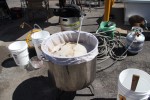 It is my personal belief that the facts of history are almost irrelevant. It is the power to influence the present and the future that makes history such a great tool. Consistent with that stance, I am today going to set forth a handful of historical nougats related to beer. I have picked them up various places along the way as I have negotiated by career as a human thus far. Most of those sources have become shrouded in the dark veil of boozy time, but the interesting “facts” remain. Without substantially more effort, I can’t exactly verify the complete accuracy of the things below, but to the extent that they help us appreciate beer now and in days to come, they have done their job. If any of these pique your interest enough, let me know, and I might endeavor to do a little more academically sound treatment. Without further ado:
It is my personal belief that the facts of history are almost irrelevant. It is the power to influence the present and the future that makes history such a great tool. Consistent with that stance, I am today going to set forth a handful of historical nougats related to beer. I have picked them up various places along the way as I have negotiated by career as a human thus far. Most of those sources have become shrouded in the dark veil of boozy time, but the interesting “facts” remain. Without substantially more effort, I can’t exactly verify the complete accuracy of the things below, but to the extent that they help us appreciate beer now and in days to come, they have done their job. If any of these pique your interest enough, let me know, and I might endeavor to do a little more academically sound treatment. Without further ado:
Did you know that beer served as a form of currency in several ancient civilizations? As a method of concentrating and further enhancing grain wealth, beer was a popular way to transfer value. A day of service of some kind or other could result in the payment of a jug of beer that was, I imagine, a welcome form of compensation after a hard day of milling about doing whatever it is ancient people did all day. There are records to indicate that laborers for ancient architecture, including the Pyramids of Egypt were given daily rations of beer. Quite large rations as I understand it. What this means is that you shouldn’t worry too much if you feel like you drink away your whole paycheck. You are part of a long and proud line of individuals who worked for fermented barley juice.
Did you know that each Viking village had a “magic stick” used to make the beer? Because most professions were passed on within a family, the brewer in a village would train a son to be a brewer and would pass on to that son all the proprietary implements of brewing. Chief among these implements was the magic brewing stick. No other stick would do. Most sticks stirred in the beer would result in unacceptable drinking, but the one magic stick made the beer bubble and gave it the enchanting effects of intoxication. With our modern understanding of microbiology, we now know that the magic stick must have been the one that had been inoculated with the right yeast to get the job done. Porous wood served as a great home for those little critters to set up shop, and every time the stick was stirred in a hospitable food source, they jumped into the liquid and went to town turning sugar water into beer.
Did you know that beer was the staple beverage for man, woman, and child in Medieval Europe? Due to the same stellar handling of infectious disease threats that lead to the sweeping success of the Black Plague, medieval Europeans found one way or another to render most of their water supplies extremely gross. They found that drinking directly from the stream right next to Ye’ Olde Poo Depot generally made you ill and often killed you. Since moving the aforementioned Depot was right out of the question, they decided to do something to the water to make it safe. It turns out that beer made from that very same water killed you markedly less often. Hooray! Again, our marginally better understanding of the workings of the Universe now tell us that boiling water kills the harmful microorganisms in it, and alcohol and hops both help to preserve it against post-brewing infection. Weak beer made out of gross water may not have been delicious, but it was way safer than drinking it un-brewed.
Did you know that beverages at communal gathers used to be consumed from large vessels meant to be shared? Beer and other drinks that ancient people tended to imbibe in groups were often served out of a large bowl or pitcher that was passed around from person to person or that sat in the middle of the table so everyone could drink from it with their own straw. The straw method offered the additional benefit of being able to drink from the liquid in the middle of the container without getting a mouthful of floating grain or other miscellaneous debris that may inhabit the surface of the liquid. In the modern age of single-drinker serving vessels, we still hold on to a vestige of these old communal vessels. When making a toast or when simply acknowledging drinking companions, we often touch our glasses together. This touching is a symbolic union of our glasses into a single vessel to show that, though we have separate vessels, we still drink as a community. Cheers, and I’ll catch you next time! Until then, faithful readers, thanks for reading, and happy drinks!
P.S. Remember to let me know if you have some specific topic you would like me to babble about next time. You can tell me in person, by e-mail, or in the comments right down below.





